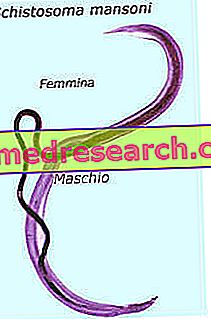Generality
The term schistosomiasis identifies a group of parasitic diseases caused by trematodes, true flat worms (platelminti) belonging to the genus Schistosoma. At the adult stage the parasites reach the length of 0.7 - 1.2 cm, localizing themselves in the venous circulatory system of the host.
Depending on the district affected by the complications, we speak of intestinal, rectal, bladder, hepato-portal, splenic or pulmonary schistosomiasis.
Among the species of schistosoma that can affect humans are:
- Schistosoma mansoni (Arabia, Africa, South America, the Caribbean) and Schistosoma intercalatum (West and central Africa) responsible for intestinal schistosomiasis
- Schistosoma haematobium (Africa, along the course of the Nile, and Middle East) responsible for urinary schistomatosis
- Schistosoma japonicum (China and the Philippines) and Schistosoma mekongi (Southeast Asia) responsible for intestinal schistosomiasis

Transmission and illness
Schistosomiasis is transmitted through skin contact with infected water, affecting mainly children playing with polluted water sources. As anticipated, the adult worm lives in the venous plexuses of the bladder and intestine, depositing eggs (cercaria) capable of opening a gap in the walls of these organs and mingling with feces and urine, through which they are expelled outside. Once they reach the aquifers, the parasite eggs hatch, releasing small larvae, which infect an intermediate host, represented by molluscs adhering to the stem of some aquatic plants; inside the mollusc, the larvae multiply and after a few days they free themselves in the water infecting humans.

Symptoms and complications
To learn more: Schistosomiasis symptoms
Symptoms of schistosomiasis vary according to the worm species involved and the stage of infection:
- larval skin invasion can cause dermatitis with itching and skin rash, thanks to the immune processes that destroy the larvae; for this reason it is typical of the subjects already sensitized to the parasite;
- severe infestation (acute schistosomiasis) can cause fever and chills, weight loss, cough and headache, accompanied by lymphadenopathy, hepatomegaly and splenomegaly (enlarged lymph nodes, liver and spleen);
- Intestinal schistomatosis essentially manifests itself with diarrhea, sometimes blood, alternating with periods of remission (alterations in the alvus, often accompanied by blood in the stool); the intestinal mucosa has ulcerative, granulomatous and polyposis lesions;
- Urinary schistomatosis occurs mainly with frequent urination, dysuria (pain on urination) and hematuria (blood in the urine);
When the eggs pass through the bladder and enteric walls they can become trapped there, triggering local inflammatory reactions that cause haematuria and haemorrhea (loss of blood with urine and faeces); local inflammation causes histological changes in the urinary tract, with fibrotic processes affecting the bladder and dilation of the ureters, up to renal failure with increased predisposition to bladder cancer. In intestinal schistomatosis, on the other hand, worms can reach the liver through the portal circle, triggering inflammatory processes with liver fibrosis and cirrhosis; this leads to a stage of portal hypertension, with possible bleeding of esophageal varices.
Diagnosis, therapy and prevention
To learn more: Drugs for the treatment of Schistosomiasis
The diagnosis of schistomatosis arises by searching for the eggs of the parasite in the urine or in the faeces, or by means of antibody tests on blood samples taken from the patient (useful above all in the acute phase, when the symptoms are non-specific and in the droppings there are no eggs, but also in the late phase, when the ovoposition tends to become negative). Endoscopic and biopsy tests are useful for assessing organ complications of the disease.
The treatment of choice is represented by an anthelmintic called praziquantel, generally administered in a single dose per os; alternatively, metersfonate and oxamnichine can be used. Its effectiveness is good (60-80% of cases), given the demonstrated ability to reverse the chronic complications of schistomatosis; dosage:
- Schistosoma mansoni, Schistosoma intercalatum, Schistosoma haematobium : 40mg / kg in single dose
- Schistosoma japonicum : 60mg / kg divided into 2/3 doses over 24 hours
- Schistosoma mekongi : 60mg / kg to be repeated twice
The prevention of schistomatosis is based on the reclamation of aquifers, on the construction of sewage networks, and on public awareness campaigns (reducing the contamination of water courses with faeces and urine, and avoiding contact with the water of rivers and lakes ).



